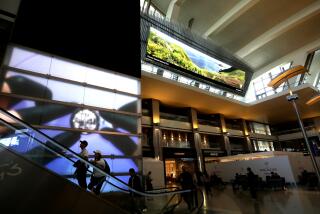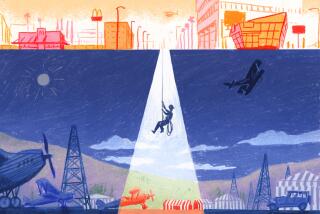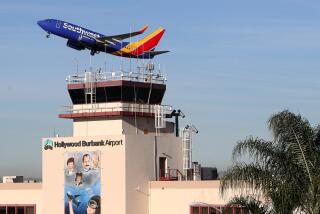5 Sites Fighting for O’Hare’s Leftovers : The big airport is crowded and the Windy City has competition to snare a new one.
- Share via
The world’s busiest airport is getting too much business.
Neighbors of Chicago’s O’Hare International Airport have long been upset over its noise and fumes, and air travelers are increasingly choosing to make connections in other cities rather than endure delays during peak hours. O’Hare simply has reached its capacity.
So, seeking to lighten the facility’s passenger load and maintain the city’s role as the nation’s preeminent air transportation center, officials here are planning to build a new airport. The question is where to put it.
Seeking the prize are Gary, Ind., three sparsely populated towns south of Chicago and Chicago itself. The choice should be made by later this month.
The multibillion-dollar airport will be one of the greatest single generators of jobs in the Chicago region’s history. Because of this, and because two of the five sites under consideration would require the displacement of thousands of homes, the battle over where to build the airport has often become emotional.
BACKGROUND: For years, while the other Illinois towns and northwestern Indiana slugged it out over who might get the new airport, Chicago officials maintained that another facility was unnecessary. Chicago feared that it might hurt the city’s economy by siphoning flights from O’Hare and the smaller, older Midway Airport.
But a 1988 study commissioned by the transportation departments of Illinois, Wisconsin and Indiana estimated that by the year 2020, unless capacity was increased, Chicago’s two airports would be turning away 15 million passengers a year. The impact on the economy would be huge. Something clearly needed to be done.
Mayor Richard M. Daley reversed the city’s long-held opposition to a new airport two years ago, proposing a most unlikely site--the gritty Lake Calumet industrial section on the city’s southeast side, near the Indiana border.
An airport there would obliterate more than 1,000 acres of wetlands, require a costly toxic waste cleanup and destroy deep-rooted neighborhoods. Nevertheless, almost as soon as he made the proposal it became the site to beat, at least in part because, as a city-operated facility, it could benefit from a new federal law for which Daley lobbied that permits Chicago to impose a passenger ticket tax. Daley contends that a $3-per-passenger levy at O’Hare and Midway airports would generate $90 million a year to help finance the new facility.
Daley’s preferred site and the Gary location share many of the same environmental and disruption problems, but their champions are pushing hard because the new airport would mean economic benefits for depressed areas.
O’Hare, with 800,000 flights yearly, provides 50,000 jobs and pumps an estimated $11 billion a year into the economy of a six-county region. The new airport, although smaller, would have similar impact and would greatly transform its immediate surroundings.
But politicians, businesses and labor organizations from suburban Chicago to Central Illinois say they deserve a share of the economic windfall and say an airport built on farmland south of Chicago would be much less disruptive and less expensive.
ALTERNATIVES: No more than 1,370 residents and 135 jobs would be displaced if a so-called “green-field” site is selected, as opposed to the minimum 24,700 residents and 4,000 to 15,000 jobs that would be displaced on an urban site. An airport on one of the green-field sites, on the Illinois-Indiana border, or near the towns of Peotone or Kankakee, would cost an estimated $4 billion tops, whereas the cost of building in Chicago or Gary ranges from $10 billion to almost $18 billion. A green-field site also would add fewer planes to Chicago’s already crowded airspace.
The major disadvantage, besides the loss of 40,000 acres of farmland, is the distance of the green-field sites from downtown Chicago--30 to more than 50 miles. One study done at the University of Illinois said such a location could prove an “embarrassment” because it would draw so few passengers. But for green-field proponents--especially those from Central Illinois--the distance from Chicago is a plus.
“It just makes no sense to me to put a third airport in the same geographical area that already has two,” said Bob Herrick, vice president of the Will County Chamber of Commerce, which is lobbying for a green-field site.
One proposal by a city labor leader that recently won Daley’s endorsement would scatter pieces of the airport--and therefore the wealth--throughout the region: Southeast Chicago would get the runways and gates, and satellite terminals would be built in Gary, downtown Chicago and the south suburbs. Passengers could check their luggage at the far-flung terminals, then take high-speed rail cars to the main facility to board their planes.
So far, the only option that has been ruled out by the bistate panel that is expected to make its selection Jan. 24 is the option of doing nothing. The panel, whose 11 members were appointed by the governors of Illinois and Indiana and by Daley, decided last month that an airport definitely should be built.
Proposed Airport Sites
1. Lake Calumet
2. Gary
3. Bi state
4. Peotone
5. Kankakee
More to Read
Sign up for Essential California
The most important California stories and recommendations in your inbox every morning.
You may occasionally receive promotional content from the Los Angeles Times.










